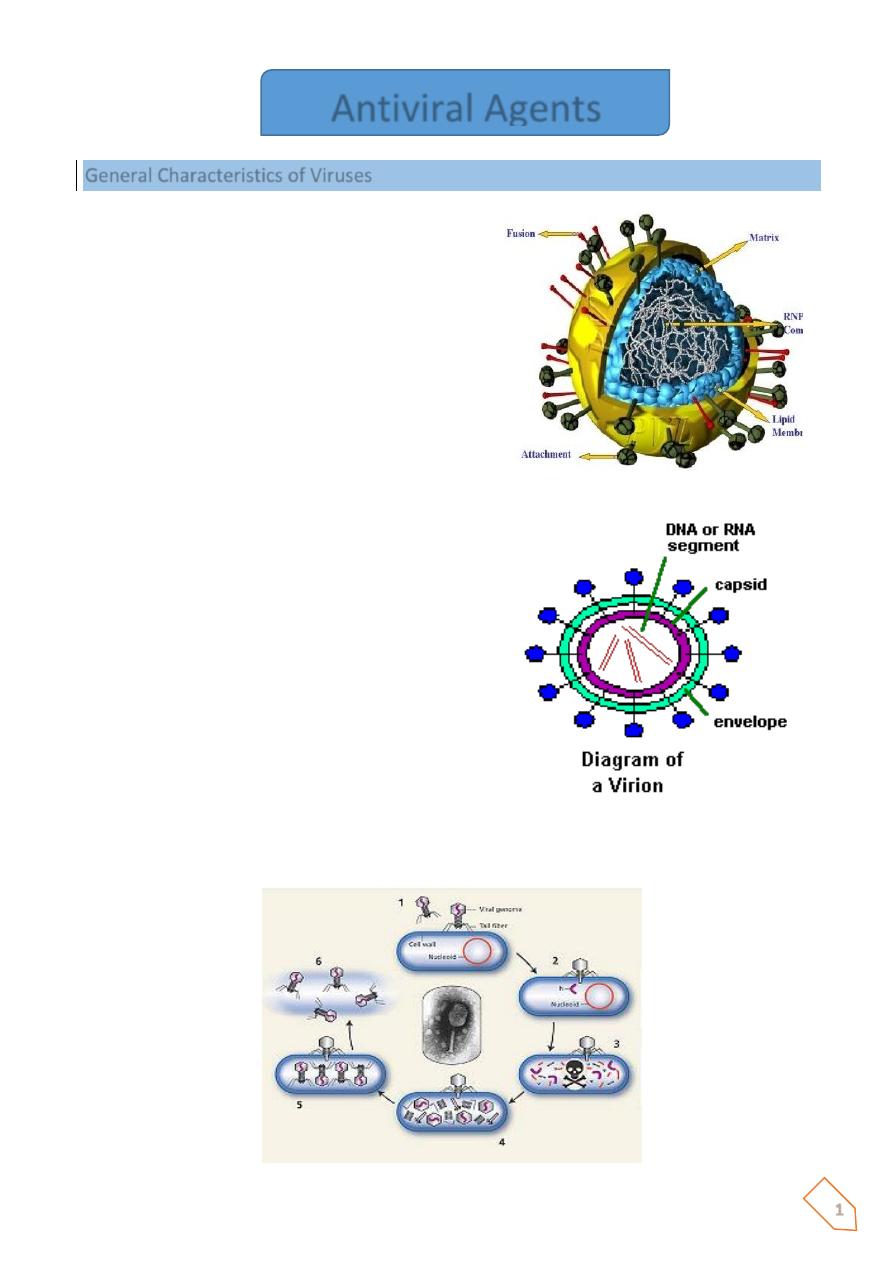
1
General Characteristics of Viruses
Depending on one's viewpoint, viruses may
be regarded as exceptionally complex
aggregations of
nonliving
chemicals or as
exceptionally simple
living
microbes.
Viruses contain a single type of nucleic acid
(DNA or RNA) and a protein coat,
sometimes enclosed by an envelope
composed of lipids, proteins, and
carbohydrates.
Viruses are obligatory intracellular parasites. They multiply by using the host cell's
synthesizing machinery to cause the synthesis of specialized elements that can transfer the
viral nucleic acid to other cells.
Antiviral Agents
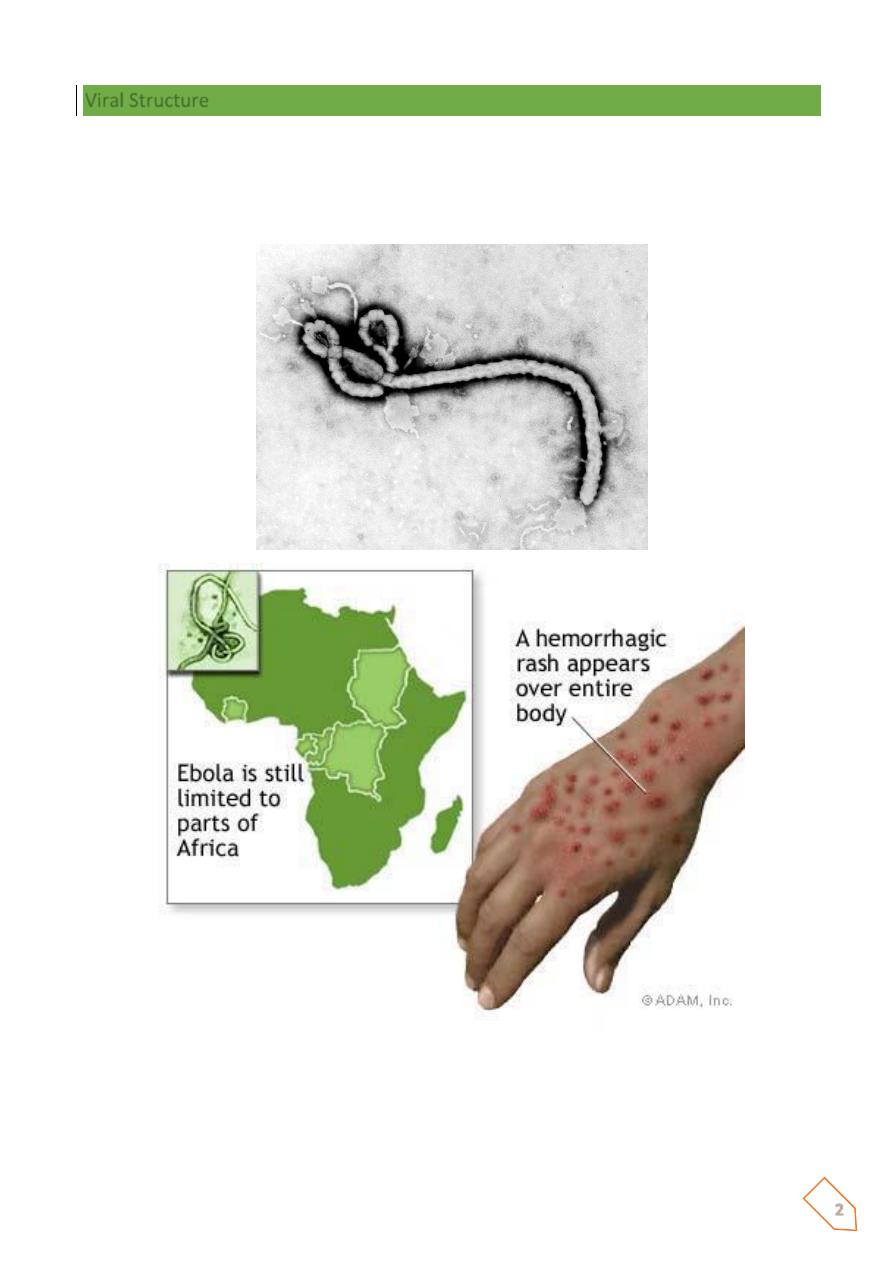
2
Viral Structure
A virion is a complete, fully developed viral particle composed of nucleic acid
surrounded by a coat.
Helical viruses (for example, Ebola virus) resemble long rods and their capsids are
hollow cylinders surrounding the nucleic acid.
Polyhedral viruses (for example, adenovirus) are many-sided. Usually the capsid is an
icosahedron.
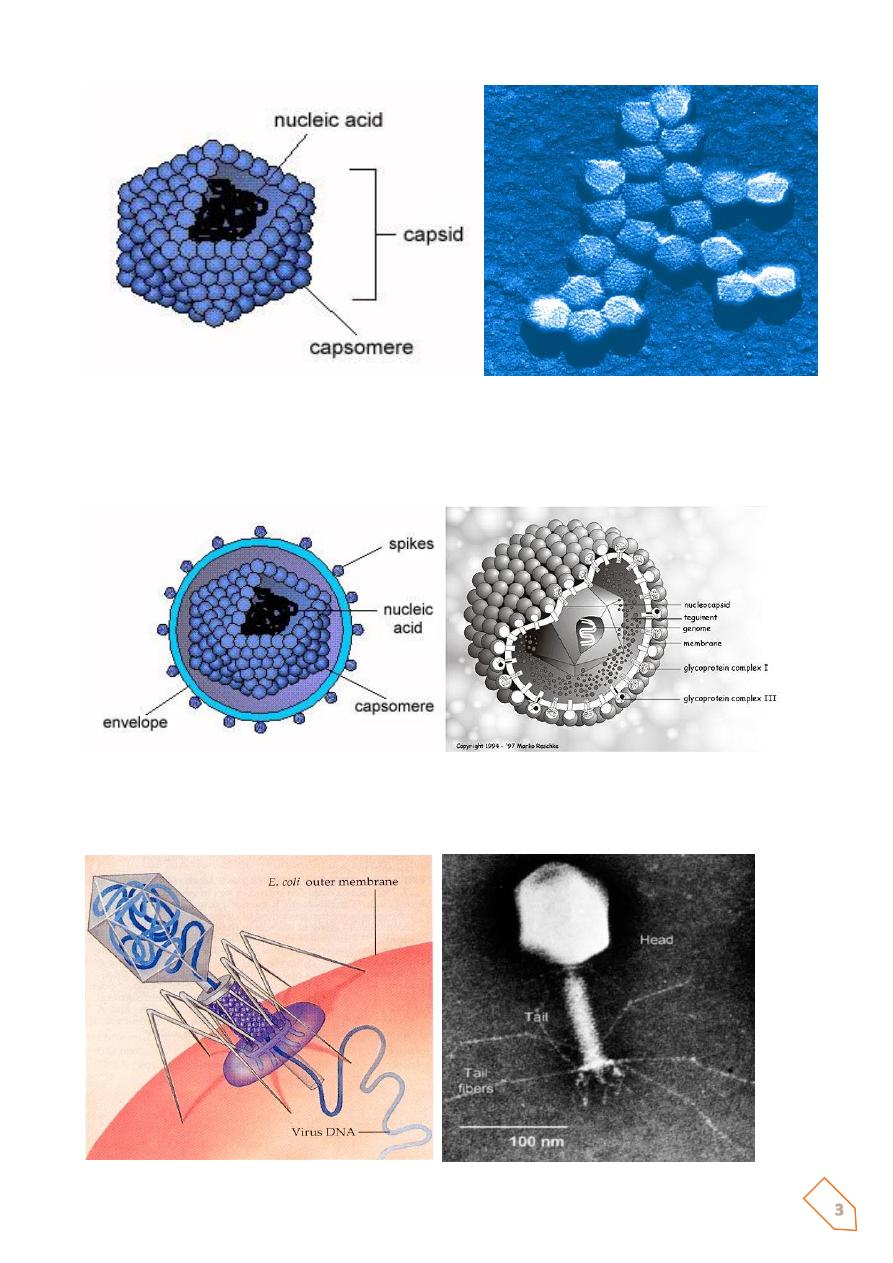
3
Enveloped viruses are covered by an envelope and are roughly spherical but highly
pleomorphic (for example, Poxvirus). There are also enveloped helical viruses (for example,
Influenzavirus) and enveloped polyhedral viruses (for example, Herpesvirus). Pleomorphic:
Many-formed. A tumor may be pleomorphic.
Complex viruses have complex structures. For example, many bacteriophages have a
polyhedral capsid with a helical tail attached. Bacteriophage: A virus that infects and lyses
certain bacteria.
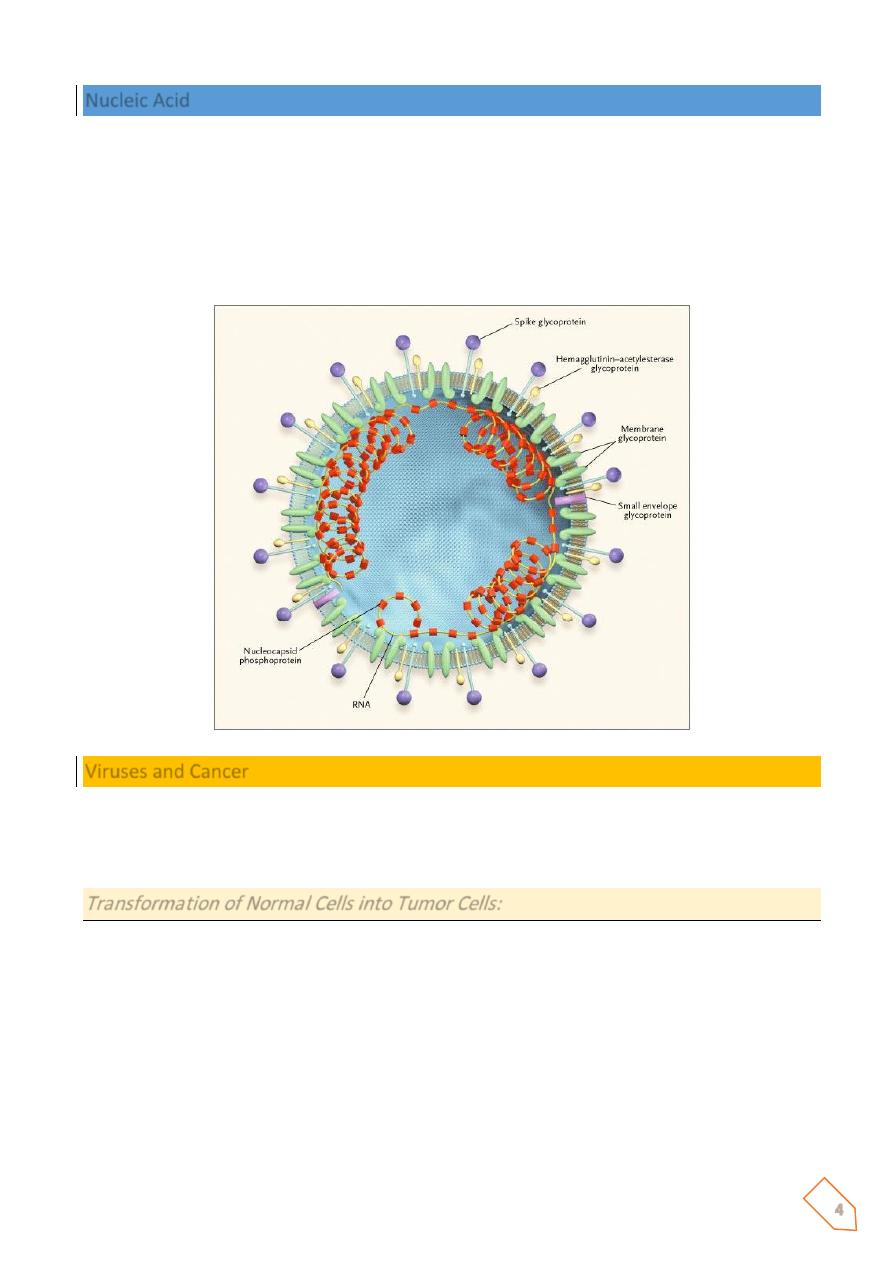
4
Nucleic Acid
• Viruses contain either DNA or RNA, never both, and the nucleic acid may be single- or
double-stranded, linear or circular, or divided into several separate molecules.
• The capsid of some viruses is enclosed by an envelope consisting of lipids, proteins,
and carbohydrates.
• Some envelopes are covered with carbohydrate-protein complexes called spikes.
Viruses and Cancer
The earliest relationship between cancer and viruses was demonstrated in the early 1900s,
when chicken leukemia and chicken sarcoma were transferred to healthy animals by cell-free
filtrates.
Transformation of Normal Cells into Tumor Cells:
When activated, oncogenes transform normal cells into cancerous cells.
Viruses capable of producing tumors are called oncogenic viruses.
Several DNA viruses and retroviruses are oncogenic.
The genetic material of oncogenic viruses becomes integrated into the host cell's
DNA.
Transformed cells lose contact inhibition, contain virus-specific antigens (TSTA and
T antigen), exhibit chromosomal abnormalities, and can produce tumors when
injected into susceptible animals.

5
Anti-influenza Agents
Amantadine · Oseltamivir · Peramivir · Rimantadine · Zanamivir
Anti-herpesvirus agents
Aciclovir · Cidofovir · Docosanol · Famciclovir · Foscarnet · Fomivirsen · Ganciclovir ·
Idoxuridine · Penciclovir · Trifluridine · Tromantadine · Valaciclovir · Valganciclovir ·
Vidarabine
Antiretroviral Agents
NRTIsZidovudine · Didanosine · Stavudine · Zalcitabine · Lamivudine · Abacavir · Tenofovir
NNTI’s
Nevirapine · Efavirenz · Delavirdine
PIsSaquinavir · Indinavir · Atazanavir · Ritonavir · Nelfinavir · Amprenavir · Lopinavir ·
Tipranavir
Other antiviral agents
Fomivirsen · Enfuvirtide · Imiquimod · Interferon · Ribavirin · Viramidine
What are Antiviral agents
Antiviral agents are used to inhibit production of viruses that cause disease. Most
antiviral agents are only effective while the virus is replicating.
It is difficult to find medicines that are selective for the virus as viruses share most of
the metabolic processes of the host cell. However, some enzymes are only present in
viruses and these are potential targets for antiviral drugs.
Agents that inhibit the transcription of the viral genome are DNA polymerase inhibitors
and reverse transcriptase inhibitors. Protease inhibitors inhibit the post-translational
events. Other antiviral agents inhibit the virus from attaching to or penetrating the
host cell. Immunomodulators induce production of host cell enzymes, which stop viral
reproduction. Integrase strand transfer inhibitors prevent integration of the viral DNA
into the host DNA by inhibiting the viral enzyme integrase. Neuraminidase inhibitors
block viral enzymes and inhibit reproduction of the viruses.
Types of Antiviral agents
• adamantane antivirals
• antiviral boosters
• antiviral combinations
• antiviral interferons
• chemokine receptor antagonist
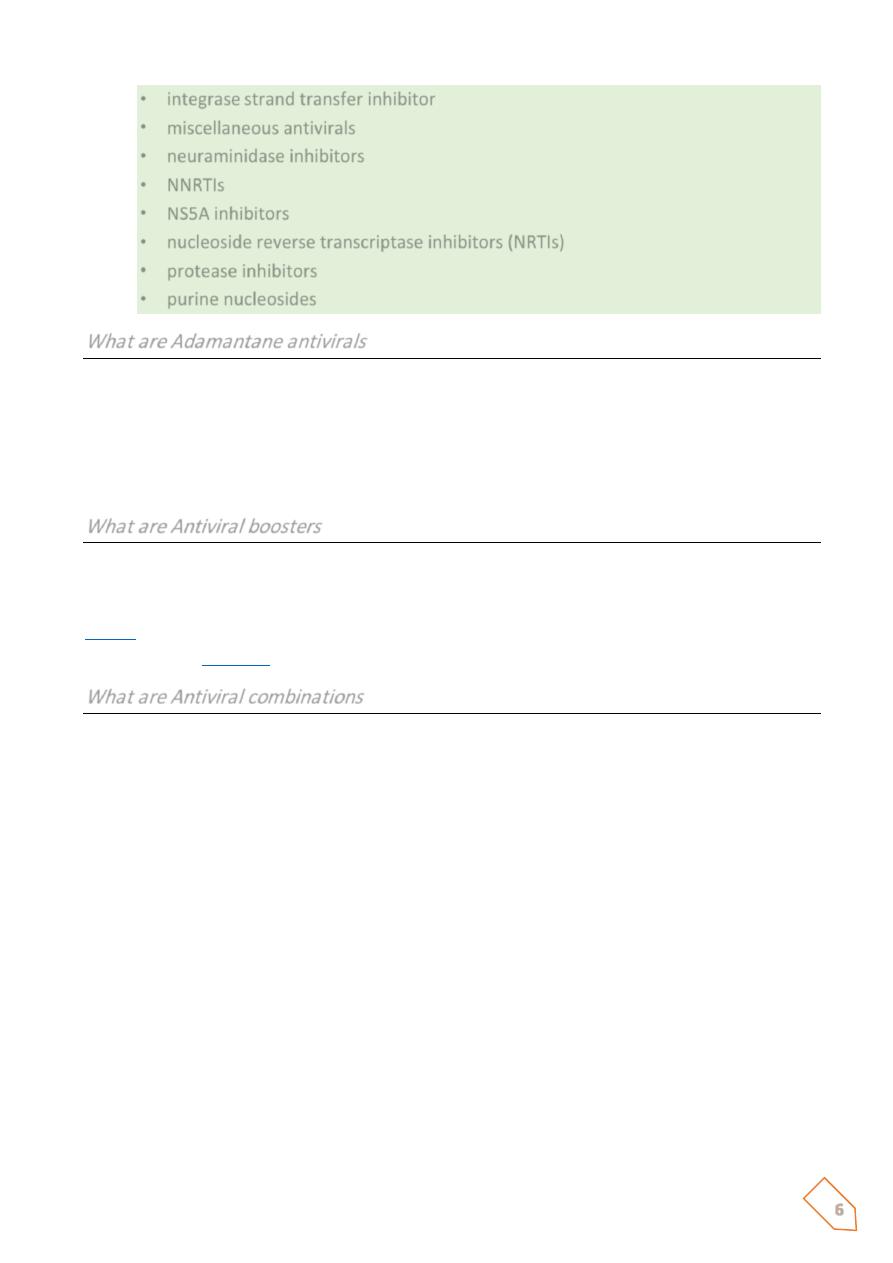
6
• integrase strand transfer inhibitor
• miscellaneous antivirals
• neuraminidase inhibitors
• NNRTIs
• NS5A inhibitors
• nucleoside reverse transcriptase inhibitors (NRTIs)
• protease inhibitors
• purine nucleosides
What are Adamantane antivirals
Adamantane antivirals are only active against influenza A virus, an RNA virus, but has no
action against influenza B virus. A viral membrane protein, M2, functions as an ion channel at
two stages of the viral replication within the host cell. These stages are the fusion of viral
membrane and endosome membrane, and the assembly and release of new virions.
Adamantane antivirals block this ion channel.
What are Antiviral boosters
Antiviral boosters are drugs that are used in conjunction with other specific antiviral drugs to
enhance or increase their effect
generic name:
What are Antiviral combinations
Antiviral combinations have more than one antiviral agent in the one pill or dose. Using a
combination of antiviral agents reduces the risk of resistant virus strains from emerging.
Antiviral agents are used to inhibit production of viruses that cause disease. Most antiviral
agents are only effective while the virus is replicating.
It is difficult to find medicines that are selective for the virus as viruses share most of the
metabolic processes of the host cell. However, some enzymes are only present in viruses and
these are potential targets for drugs.
Agents that inhibit the transcription of the viral genome are DNA polymerase inhibitors and
reverse transcriptase inhibitors. Protease inhibitors inhibit the post-translational events.
Other antiviral agents inhibit the virus from attaching to or penetrating the host cell.
Immunomodulators induce production of host cell enzymes, which stop viral reproduction.
Integrase strand transfer inhibitors prevent integration of the viral DNA into the host DNA by
inhibiting the viral enzyme integrase. Neuraminidase inhibitors block viral enzymes and
inhibit reproduction of the viruses.
•

7
Interferons
• Natural interferons are produced by lymphocytes as part of an immunological
response to viral antigens. Synthetic interferons, made by recombinant DNA
technology, are used as antiviral agents to treat infections such as hepatitis and herpes
zoster virus.
• Interferons induce the production of enzymes in the ribosomes of the host cells and
inhibit the translation of viral mRNA into viral proteins, therefore stop viral
reproduction.
Chemokine receptor antagonist
Chemokine receptor antagonists inhibit the entry of human immunodeficiency virus (HIV) into
the host cell. Two chemokine receptors, CXCR4 and CCR5, are necessary for the virus to enter
the cell, so by inhibiting these chemokine receptors the disease can be slowed.
Protease inhibitors
• Protease inhibitors are synthetic drugs that inhibit the action of HIV-1 protease, an
enzyme that cleaves two precursor proteins into smaller fragments. These fragments
are needed for viral growth, infectivity and replication. Protease inhibitors bind to the
active site of the protease enzyme and prevent the maturation of the newly produced
virions so that they remain non-infectious.
• Protease inhibitors are used in the treatment of human immunodeficiency virus (HIV
infection) and acquired immune deficiency syndrome (AIDS).
Purine nucleosides
• Purine nucleosides are antiviral agents that have selective activity against herpes
simplex virus types 1 (cold sores) and 2 (genital herpes) and varicella zoster virus
(chicken pox).
• The purine nucleoside molecule is converted to a monophosphate by viral thymidine
kinases. The monophosphate is then converted to diphosphate and then into a
triphosphate form by cellular enzymes. The triphosphate form blocks the replication
of viral DNA by inhibiting viral DNA polymerase and terminating the growing viral DNA
chain.
• These purine nucleoside analogues mimics guanosine nucleosides in their chemical
structures and includes vidarabine acyclovir, and ganciclovir
Mechanisms of actions
• Vidarabine is phosphorylated by cellular kinases to a triphosphate compound, which is
an inhibitor and a substrate of viral DNA polymerase.

8
• When used as a substrate for viral DNA polymerase, the phosphrylated compound
competitively inhibits dATP leading to the formation of ‘faulty’DNA.
• This results in the prevention of DNA synthesis, as phosphodiester bridges can longer
to be built, destabilizing the strand
• Acyclovir is phosphorylated by virus-induced thymidine kinase to the triphosphate
form, which is a better substrate and inhibitor of viral DNA polymerase,compared
with host.
• Binding to DNA polymerase is irreversible and once incorporated into viral DNA,
the DNA chain is terminated.
• The mechanism of action of ganciclovir is similar to that of acyclovir.
Clinical applications
• Herpesviral enzymes are ~20-fold more susceptible vidarabine compared with host
DNA.
• Vidarabine is effective against chickenpox - varicella, herpes zoster and herpes
simplex.
• Acyclovir is useful against the herpesvirus family and is available as an ophthalmic
ointment, a topical ointment and cream, an IV preparation, and oral formulations.
• Ganciclovir is effective against human cytomegalovirus.
Side effects
• Ganciclovir use may cuase neutropenia and thrombocytopenia, fever, rash, GIT
symptoms, confusion and seizure.
• Vidarabine may cause bone marrow suppression andCNS problems when high
blood levels are reached.
Miscellaneous antivirals
• Antiviral agents are used to inhibit production of viruses that cause disease. Most
antiviral agents are only effective while the virus is replicating.
• It is difficult to find medicines that are selective for the virus as viruses share most of
the metabolic processes of the host cell. However, some enzymes are only present in
viruses and these are potential targets for antiviral drugs
• Agents that inhibit the transcription of the viral genome are DNA polymerase inhibitors
and reverse transcriptase inhibitors. Protease inhibitors inhibit the post-translational
events. Other antiviral agents inhibit the virus from attaching to or penetrating the
host cell. Immunomodulators induce production of host cell enzymes, which stop viral
reproduction. Integrase strand transfer inhibitors prevent integration of the viral DNA
into the host DNA by inhibiting the viral enzyme integrase. Neuraminidase inhibitors
block viral enzymes and inhibit reproduction of the viruses.

9
Influenza
Influenza is a disease caused by a member of the Orthomyxoviridae. Many features are
common with those of the paramyxovirus infections of the respiratory tract.
CLINICAL FEATURES
• Influenza is characterized by fever, myalgia, headache and pharyngitis. In addition
there may be cough and in severe cases, prostration. There is usually not coryza
(runny nose) which characterizes common cold infections. Infection may be very
mild, even asymptomatic, moderate or very severe.
• Source The reservoir is acute infection in other human beings.
• Spread Is rapid via aerial droplets and fomites with inhalation into the pharynx or
lower respiratory tract.
• Incubation Is short: 1-3 days. Rapid spread leads to epidemics
Complications
Tend to occur in the young, elderly, and persons with chronic cardio-pulmonary diseases
Consist of:
1. Pneumonia caused by influenza itself; Pneumonia: an inflammatory condition of the
lungs in which they become obstructed with fluid, causing difficult breathing and
possibly suffocation. Pneumonia may be caused by bacteria, viruses, fungi, or chemical
agents.
2. Pneumonia caused by bacteria- Haemophilus influenzae- Staphylococcus aureus-
Streptococcus pneuminiae
3. Other viral superinfection, eg. Adenovirus.Overall death rates increase in times of
influenza epidemics.
Epidemiology
Influenza A virus is essentially an avian virus that has "recently" crossed into mammals. Birds
have the greatest number and range of influenza strains. Avian haemagglutinins sometimes
appear in pig human and horse influenza strains.
• Every now and then (10 - 15 years) a major new pandemic strain appears in man, with
a totally new HA and sometimes a new NA as well (antigenic shift). This variant causes
a major epidemic around the world (pandemic).
• Over the subsequent years this strain undergoes minor changes (antigenic drift) every
two to three years, probably driven by selective antibody pressure in the populations
of humans infected.
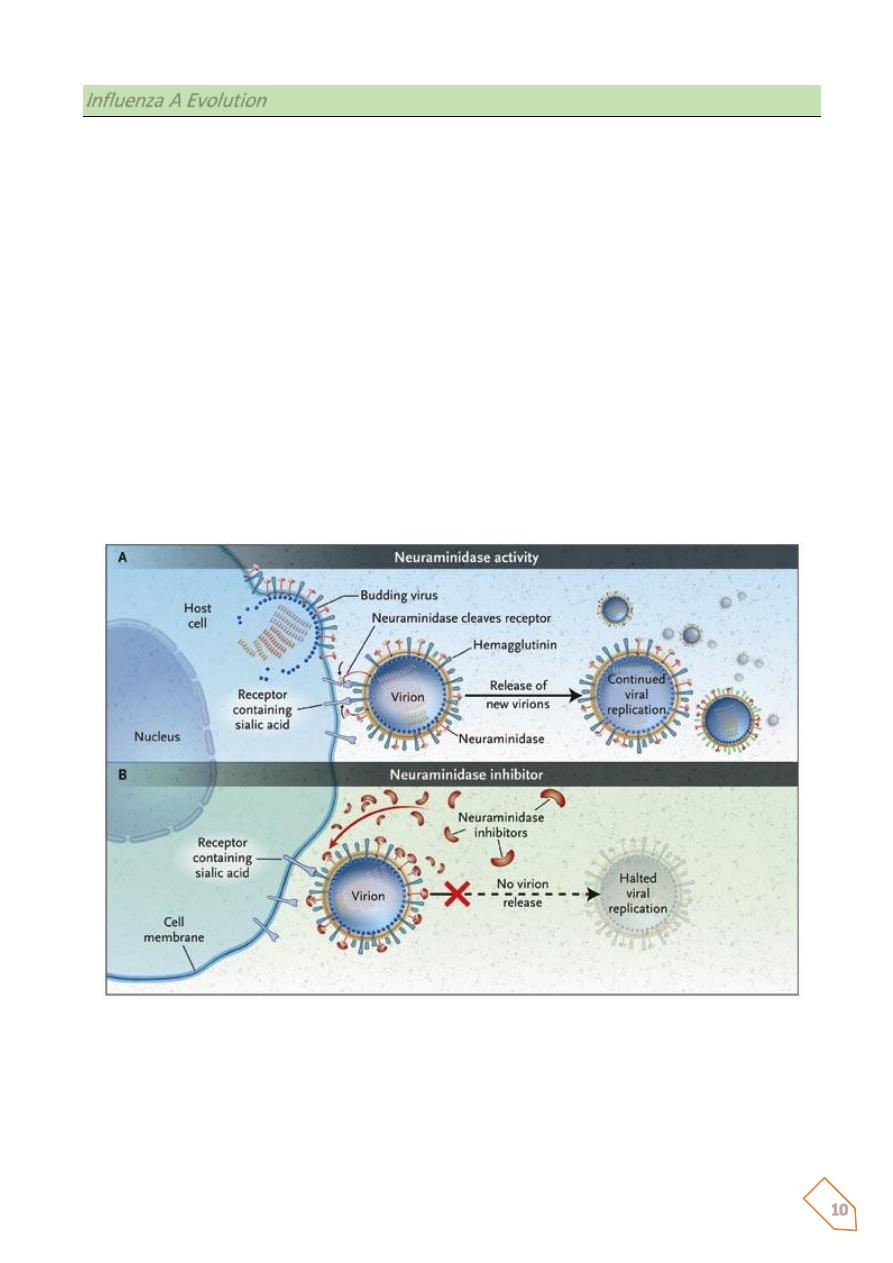
10
Influenza A Evolution
o 1874 --- (H3N8)
o 1890 --- (H2N2) .........................Pandemic
o 1902 --- (H3N2)
o 1918 --- (H1N1)..........................Pandemic
o 1933 --- (H1N1)..........................First strains isolated
o 1947 --- (H1N1)..........................Variation detected
o 1957 --- (H2N2).........................."Asian" Flu pandemic
o 1968 --- (H3N2).........................."Hong Kong" Flu pandemic
o 1976 --- (H1N1).........................."Swine" Flu, non-epidemic
o 1977 --- (H1N1) + (H3N2)........."Russian" Flu epidemic
This constant antigenic change down the years means that new vaccines have to be made on
a regular basis.
New influenza strains spread rapidly in children in schools and in places where people crowd
together. Influenza epidemics may cause economically significant absenteeism.
The final stage in the life cycle of a virus is the release of completed viruses from the host cell,
and this step has also been targeted by antiviral drug developers. Two drugs named zanamivir
and oseltamivir that have been recently introduced to treat influenza prevent the release of
viral particles by blocking a molecule named neuraminidase that is found on the surface of flu
viruses, and also seems to be constant across a wide range of flu strains.
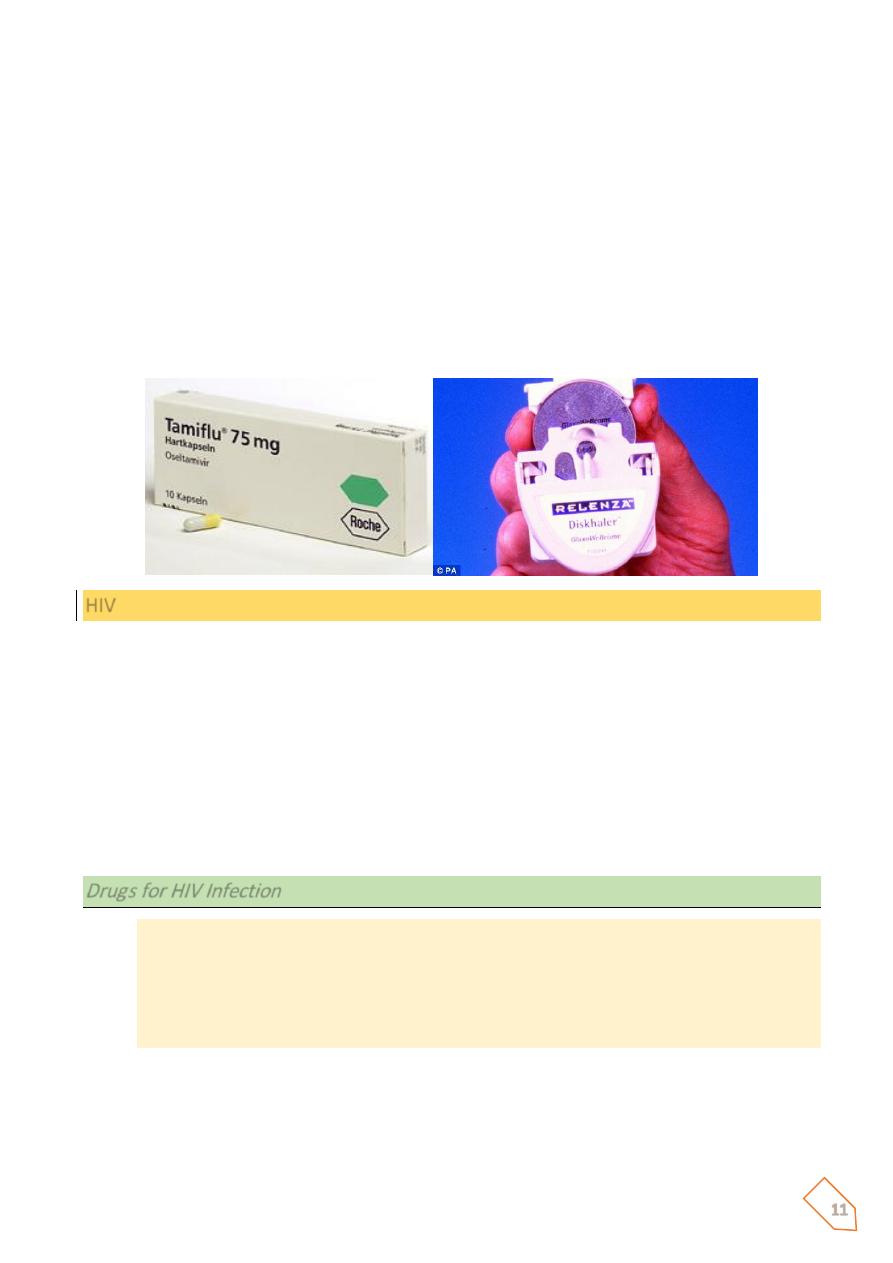
11
Most attention has been given to oseltamivir (Tamiflu) because it is a tablet, which is easy to
administer. Zanamavir (relenza) is administered as a dry powder inhaler much like some
asthma inhalers. An intravenous version of Relenza has been administered to volunteers
under study conditions but it is not yet approved or in production.
Both drugs can be used to treat influenza; they are also both approved for the prevention of
influenza. These drugs are also effective against all strains of influenza A, unlike vaccines
which are specific only to the strain for which they were designed.
Both medications are well tolerated with few side effects, although there is concern over the
possibility of psychological effects of Tamiflu and there may be occasional problems with
asthmatics who use Relenza.
HIV
o Unique features
o 2 proteins on surface of virus bind with 2 sites on CD4+ cell
o Virus infiltrates into genetic material
o Reverse transcriptase enzyme enables virus to become double stranded DNA
o Once double-stranded DNA, like the host cell, HIV can infiltrate cell nucleus of
target cell
o Gains entry into target cell nucleus with aid of Integrase
o Following integration and replication, long protein chain is cleaved. Pieces then
form into new viral particle
Drugs for HIV Infection
o Nucleoside reverse transcriptase inhibitors
o Nucleotide reverse transcriptase inhibitors
o Non-nucleoside reverse transcriptase inhibitors
o Protease inhibitors
o Entry inhibitors
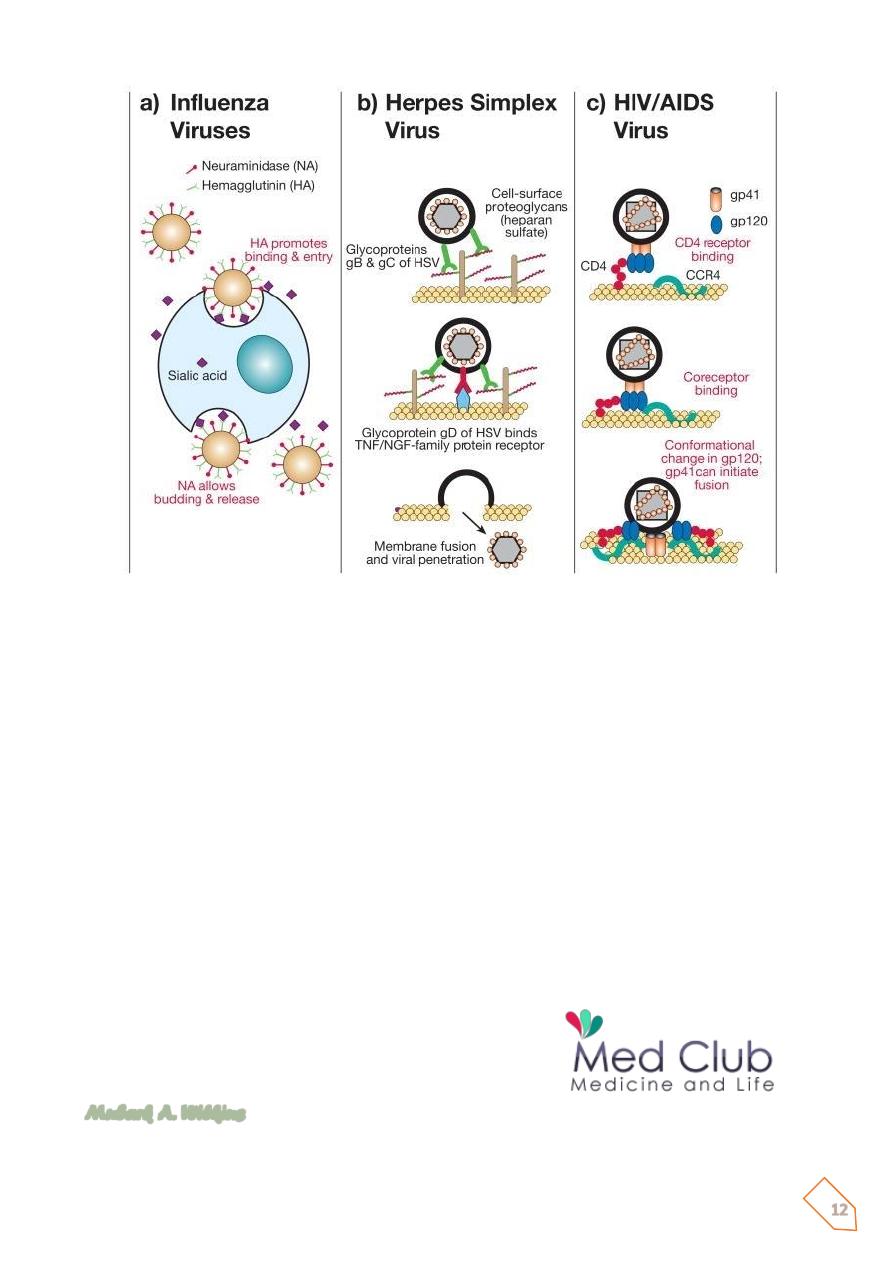
12
Mubark A. Wilkins
